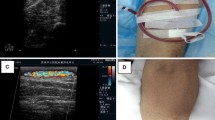Abstract
Created arteriovenous fistulas for hemodialysis in patients with renal failure can cause problems in the upper extremity. Thrombosis, bleeding, infection, and distal ischemic changes can be seen. Steal is considered as a rare phenomenon. High blood-flow volume through an arteriovenous fistula may cause stealing of blood from forearm arteries which can lead to distal hypoperfusion and peripheral ischemia as well as distal finger-tip amputations and even spontaneous ulcerations. Herein, two patients admitted to our outpatient clinic by finger necrosis have been reported, and the aim of this paper is to highlight a rare but serious complication of arteriovenous fistula and discuss what should be done to prevent finger necrosis and the strategies that can be done in the case of finger necrosis which might be of interest for the clinicians.
Level of Evidence: Level V, risk/prognostic study.

Similar content being viewed by others
References
Gökşin İ, Baltalarlı A, Önem G, Rendeci O, Saçar M, Kara H, Tulukoğlu E, Göktoğan T (2004) Arterıovenous fistula operations: its early and late-term complications that need to revision. Turkish J Thorac Cardiovasc Surg 12:180–183
Yeager R, Moneta GL, Edwards JM, Landry GJ, Taylor LM Jr, McConnell DB, Porter JM (2002) Relationship of hemodialysis access to finger gangrene in patients with end-stage renal disease. J Vasc Surg 36(2):245–249
English C, Doyle A, Hammert WC (2011) Arterial steal syndrome. J Hand Surg Am 36(6):1089–1090, quiz 1091
Leon C, Asif A (2007) Arteriovenous access and hand pain: the distal hypoperfusion ischemic syndrome Clin. J Am Soc Nephrol 2(1):175–183
Sumner DS (1989) Noninvasive vascular laboratory assessment. In: Machleder HI (ed) Vascular disorders of the upper extremity, 2nd edn. Futura Publishing, New York, pp 9–57
Fraioli F, Catalano C, Napoli A, Francone M, Venditti F, Danti M, Pediconi F, Passariello R (2006) Low-dose multidetector-row CT angiography of the infra-renal aorta and lower extremity vessels: image quality and diagnostic accuracy in comparison with standard DSA. Eur Radiol 16(1):137–146
Goff CD, Sato DT, Bloch PH, DeMasi RJ, Gregory RT, Gayle RG, Parent FN, Meier GH, Wheeler JR (2000) Steal syndrome complicating hemodialysis access procedures: can it be predicted? Ann Vasc Surg 14(2):138–144
Tynan-Cuisinier GS, Berman SS (2006) Strategies for predicting and treating access induced ischemic steal syndrome. Eur J Vasc Endovasc Surg 32(3):309–315
Plumb TJ, Lynch TG, Adelson AB (2008) Treatment of steal syndrome in a distal radiocephalic arteriovenous fistula using intravascular coil embolization. J Vasc Surg 47(2):457–459
Conflict of interest
None.
Ethical standards
Patients gave their informed consents prior to their inclusion in this case report. The manuscript does not contain any individual patient data.
Author information
Authors and Affiliations
Corresponding author
Rights and permissions
About this article
Cite this article
Baser, N.T., Celebi, N.U., Turan, A. et al. Finger necrosis: a rare complication of arteriovenous fistulas created for hemodialysis. Eur J Plast Surg 37, 403–406 (2014). https://doi.org/10.1007/s00238-014-0962-4
Received:
Accepted:
Published:
Issue Date:
DOI: https://doi.org/10.1007/s00238-014-0962-4




